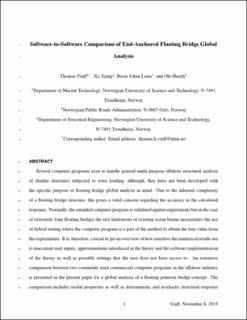| dc.contributor.author | Viuff, Thomas Hansen | |
| dc.contributor.author | Xiang, Xu | |
| dc.contributor.author | Leira, Bernt Johan | |
| dc.contributor.author | Øiseth, Ole Andre | |
| dc.date.accessioned | 2021-03-15T08:17:09Z | |
| dc.date.available | 2021-03-15T08:17:09Z | |
| dc.date.created | 2021-01-22T21:56:42Z | |
| dc.date.issued | 2020 | |
| dc.identifier.citation | Journal of Bridge Engineering. 2020, 25 (5), . | en_US |
| dc.identifier.issn | 1084-0702 | |
| dc.identifier.uri | https://hdl.handle.net/11250/2733288 | |
| dc.description.abstract | Several computer programs exist to handle general multipurpose offshore structural analysis of slender structures subjected to wave loading, although they have not been developed with the specific purpose of floating bridge global analysis in mind. Owing to the inherent complexity of a floating bridge structure, this poses a valid concern regarding the accuracy in the calculated response. Normally, the intended computer program is validated against experiments, but in the case of extremely long floating bridges the size limitations of existing ocean basins necessitate the use of hybrid testing where the computer program is a part of the method to obtain the true value from the experiments. It is, therefore, crucial to obtain an overview of how sensitive the numerical results are to inaccurate user inputs, approximations introduced in the theory, and the software implementation of the theory, as well as possible settings that the user does not have access to. An extensive comparison between two commonly used commercial computer programs in the offshore industry is presented in the present paper for a global analysis of a floating pontoon bridge concept. The comparison includes modal properties as well as deterministic and stochastic structural response owing to wave loads based on coupled hydroelastic time domain simulations. First- and second-order wave loads are included in the comparison as well as viscous drag. The study indicates reasonable agreement in the response acquired by the two computer programs and highlights the consequences of differences in some of the input parameters. | en_US |
| dc.language.iso | eng | en_US |
| dc.publisher | ASCE | en_US |
| dc.title | Software-to-Software Comparison of End-Anchored Floating Bridge Global Analysis | en_US |
| dc.type | Peer reviewed | en_US |
| dc.type | Journal article | en_US |
| dc.description.version | acceptedVersion | en_US |
| dc.source.pagenumber | 14 | en_US |
| dc.source.volume | 25 | en_US |
| dc.source.journal | Journal of Bridge Engineering | en_US |
| dc.source.issue | 5 | en_US |
| dc.identifier.doi | 10.1061/(ASCE)BE.1943-5592.0001545 | |
| dc.identifier.cristin | 1877514 | |
| dc.description.localcode | This material may be downloaded for personal use only. Any other use requires prior permission of the American Society of Civil Engineers. | en_US |
| cristin.ispublished | true | |
| cristin.fulltext | postprint | |
| cristin.qualitycode | 1 | |
